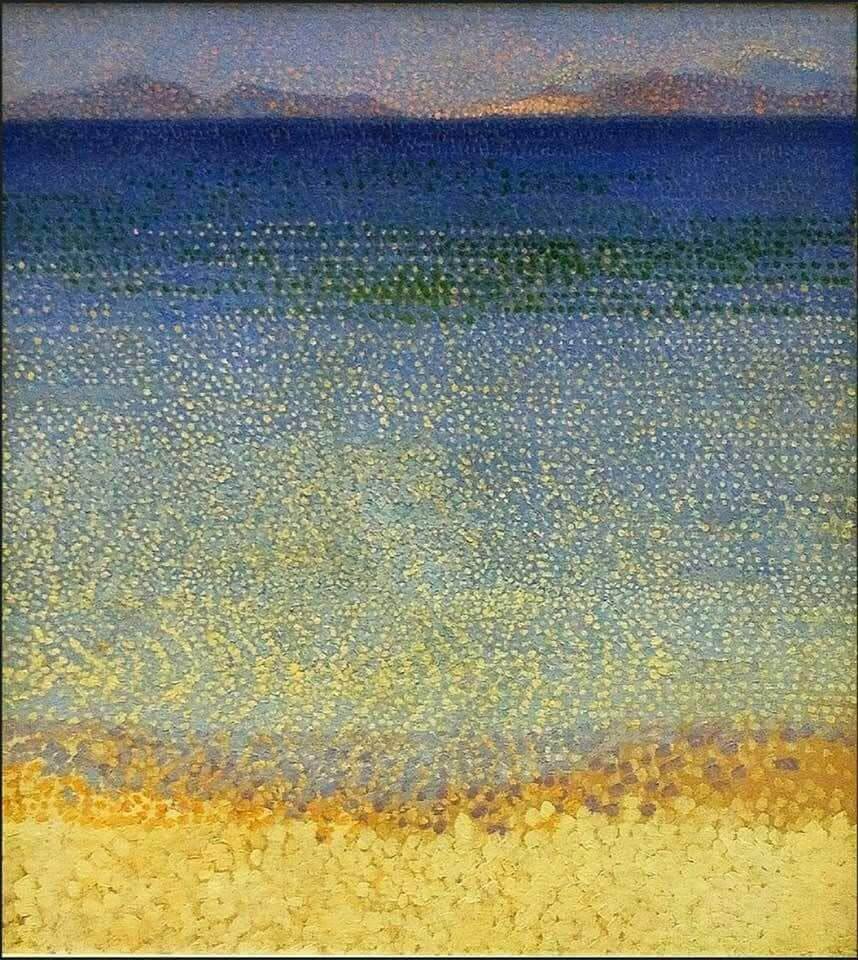‘The Iles d’Or’ – The Golden Islands. 1891 – c.1892 by Henri-Edmond Cross.

Henri-Edmond Cross (1856 – 1910) is a French artist associated with Impressionism and, Neo-impressionism, for which he is celebrated as a master. He was considered influential on many artists, including Henri Matisse and the art movement of Fauvism.
Artists were working against the constraints of the official Salon, and In 1884 Cross co-founded the ‘Society of Independent Artists’, abandoning the juried system and presenting artworks freely. Through these meetings, he befriended artists associated with Neo-impressionism, including Georges Seurat and Charles Angrand. Despite his associations with these artists, Cross did not take on their style for many years.
Pointillism and Divisionism are closely associated. Pointillism uses dots of colour but does not focus on the separation of colours. The two aesthetic approaches are often both referred to as Pointillism.
‘The Iles d’Or’ was created in an exciting time of rapidly developing experimentation and changes in painterly techniques and adopting colour theories and modern subject matter. It predates the eventual explosion of diversity and powerful creativity at the beginning of the twentieth century, the advent of Fauvism, and the ‘Modern Art period’.
This painting displays a sophisticated composition, complex use of pointillism style techniques, and colour theory. The artwork uses varying sizes of meticulously applied dots of paint to give an impression of the scene, providing the painting with a soft and atmospheric look to the landscape, looking across the sea from a sandy beach in the foreground to the mountains in the far background.
Ostensibly a simple landscape, the narrative is subservient to the importance of the paint application, colour and composition. This painting is like a luscious layer cake. The layering structure is more important than the pictorial narrative.
Since the Renaissance, blue has been used as a regressive colour to suggest atmospheric perspective and the far distance. In this painting, we see a mountainous landscape silhouetted by the sky with a patch of sunlight catching a mountainside.
Below the mountain layer is a bold dark blue band that dominates the upper part that draws the eye. The painting is usually viewed as working from top to bottom.
Throughout the painting, we see a sophisticated and subtle interweaving of colour and varying-sized applied dots of paint depicting light reflections and details in the water.
Halfway down, the dominant blue begins to give way to yellow. The cleverly applied paint suggests reflections from the upper parts and sparkling light reflections from the water. Yellow starts to give way to the blue, and the progression indicates a closeness to the viewer with the details of waves and rippling water as the sea yields to the beach. The transition is so beautifully captured and suggested. The transparency of the shallow water sparkles with contrasts of blue/orange to orange. Finally, the suggestion of wet sand gives way to the yellow of the dry sand. It is wonderfully portrayed.
Throughout the composition, there are subtle changes in the size of the applied dabs of paint. The larger dabs are at the bottom of the painting.
This is a tour de force of skill and colour experimentation and new advanced painting techniques. These factors make this more about modernism, colour theory and powerfully induced pure emotions that supersede the pictorial narrative of a landscape.
In the progression of some art, the story finally gives way to non-figuration, abstraction, where colour, shape and form become pure emotion without narrative.
This painting is at a pivotal point. Colour, shape and form have emotional resonance and emotive charge without the necessity for a story. It succinctly demonstrates the eventual beauty, power and spirituality of non-narrative artworks.
‘Love him or loathe him, Mark Rothko delivered sublimely beautiful paintings that engendered a deep divide’
In this piece of writing and description of this narrative painting, I have attempted to provide a meaningful journey towards an understanding and appreciation of the divisive works of Mark Rothko.
If you can appreciate this painting, it is a short step to the Understanding of the paintings of Mark Rothko.






















